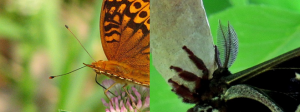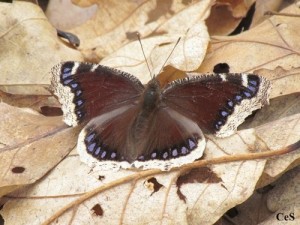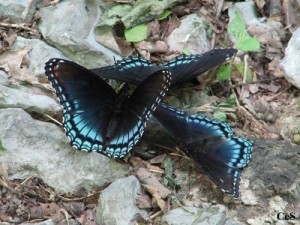March 14 is Learn about Butterflies Day! What do you know about butterflies? When I asked Charlie to share some of his knowledge and photos about butterflies, this is what he gave me….
Butterfly or Moth???
The order of insects called Lepidoptera is comprised of the creatures we call butterflies and moths, those broad-winged fliers that often seem to float along as they fly. The name Lepidoptera means “scale wing”, as the wings of almost all species are covered with fine scales.
Although there are many similarities, there are also significant differences between butterflies and moths. In general, butterflies are active during daylight while moths, with a few exceptions, are active at night. The antenna of butterflies are slender and club-like while those of moths resemble feathers (the antenna of  male moths are usually larger and more “feathery” than the antenna of females). While only a few species of butterflies appear to be drab gray or brown, many species of moths are various shades of tan, brown or gray. Resting butterflies tend to hold their wings vertically over their backs while moths usually hold their wings horizontally.
male moths are usually larger and more “feathery” than the antenna of females). While only a few species of butterflies appear to be drab gray or brown, many species of moths are various shades of tan, brown or gray. Resting butterflies tend to hold their wings vertically over their backs while moths usually hold their wings horizontally.
Charlie’s photos above highlight the antenna of a butterfly (left) and a moth (right).
First of the Year
 Soon they will emerge, the first butterflies of the year – the mourning cloaks. Occasionally there may still be patches of snow in shady areas, but on warm days of early spring mourning cloaks will emerge from hibernation. These are the only butterflies in our area that actually hibernate as adults, spending the winter in tree cavities or beneath loose bark. Mourning cloaks mate in spring after which the females lay their eggs on the host plats on which the larvae will feed – willow, wild rose, hawthorn and a number of other species. After the larvae have matured, they pupate, transforming into adult butterflies which emerge in June and July. The adults estivate (which can be thought of as summer hibernation) and emerge again in the fall to feed and store energy for winter hibernation. When the mourning cloaks emerge we know spring has arrived.
Soon they will emerge, the first butterflies of the year – the mourning cloaks. Occasionally there may still be patches of snow in shady areas, but on warm days of early spring mourning cloaks will emerge from hibernation. These are the only butterflies in our area that actually hibernate as adults, spending the winter in tree cavities or beneath loose bark. Mourning cloaks mate in spring after which the females lay their eggs on the host plats on which the larvae will feed – willow, wild rose, hawthorn and a number of other species. After the larvae have matured, they pupate, transforming into adult butterflies which emerge in June and July. The adults estivate (which can be thought of as summer hibernation) and emerge again in the fall to feed and store energy for winter hibernation. When the mourning cloaks emerge we know spring has arrived.
Puddling
Anyone who spends time outdoors in the spring or summer will, from time to time, see collections of butterflies gathered around damp spots or on animal or bird droppings. These aggregations are usually comprised of male butterflies and close observation will reveal that the butterflies proboscises are often extended and contacting the damp soil or feces. These butterflies are doing what is called “puddling”, a process whereby they drink and/or acquire  the minerals they need to survive.
the minerals they need to survive.
Butterflies can be attracted to a home garden not just by nectar producing flowers, but by an area where they can puddle. A suitable puddling spot can be made by partially filling a large flower pot saucer with soil to which a bit of salt has been added and then keeping the soil very damp; placing a few flat stones on the soil surface will give the butterflies a place to bask, especially if the puddling spot is in the sun.

